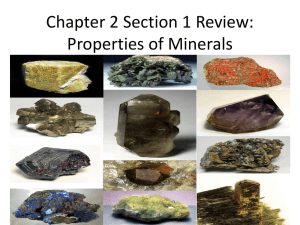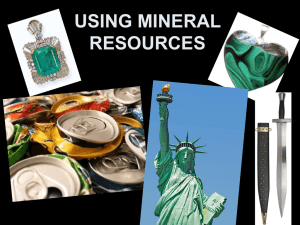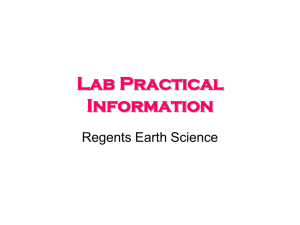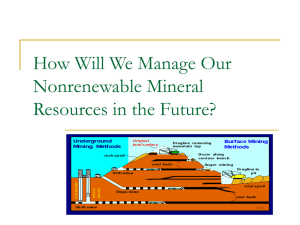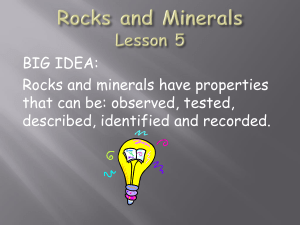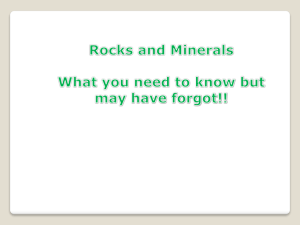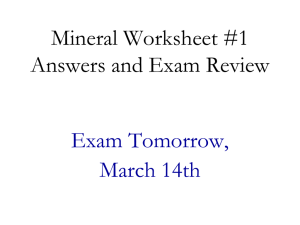A mineral occurrence is any locality where a useful mineral or
advertisement
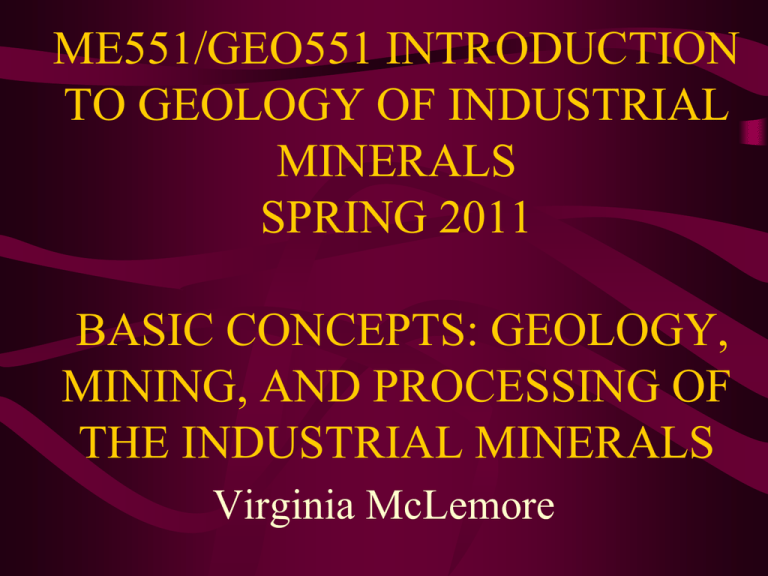
ME551/GEO551 INTRODUCTION TO GEOLOGY OF INDUSTRIAL MINERALS SPRING 2011 BASIC CONCEPTS: GEOLOGY, MINING, AND PROCESSING OF THE INDUSTRIAL MINERALS Virginia McLemore OUTLINE • Definitions • Life cycle of a mine • Classification of reserves and resources • Geology of industrial minerals • Field notes • Sampling DEFINITIONS A mineral occurrence is any locality where a useful mineral or material is found. A mineral prospect is any occurrence that has been developed by underground or by above ground techniques, or by subsurface drilling to determine the extent of mineralization. The terms mineral occurrence and mineral prospect do not have any resource or economic implications. A mineral deposit is any occurrence of a valuable commodity or mineral that is of sufficient size and grade (concentration) that has potential for economic development under past, present, or future favorable conditions. An ore deposit is a well-defined mineral deposit that has been tested and found to be of sufficient size, grade, and accessibility to be extracted (i.e. mined) and processed at a profit at a specific time. Thus, the size and grade of an ore deposit changes as the economic conditions change. Ore refers to industrial minerals as well as metals. Generally, industrial minerals are any rock, mineral, or naturally occurring substance or closely related man-made material of economic value, generally excluding metals, fuels, and gemstones. • “Without a market, an industrial mineral deposit is merely a geological curiosity” • Demand feeds back from the end-use market, to the end product, to the intermediate end product, and finally back to the mineral supplier. • Customer specifications include physical and chemical and other criteria Classification of mineral resources on U.S. Federal Land Locatable Minerals are whatever is recognized as a valuable mineral by standard authorities, whether metallic or other substance, when found on public land open to mineral entry in quality and quantity sufficient to render a claim valuable on account of the mineral content, under the United States Mining Law of 1872. Specifically excluded from location are the leasable minerals, common varieties, and salable minerals. Leasable Minerals The passage of the Mineral Leasing Act of 1920, as amended from time to time, places the following minerals under the leasing law: oil, gas, coal, oil shale, sodium, potassium, phosphate, native asphalt, solid or semisolid bitumen, bituminous rock, oilimpregnated rock or sand, and sulfur in Louisiana and New Mexico. Salable Minerals The Materials Act of 1947, as amended, removes petrified wood, common varieties of sand, stone, gravel, pumice, pumicite, cinders, and some clay from location and leasing. These materials may be acquired by purchase only. LIFE CYCLE OF A MINE Stages of Mining • • • • • • • Exploration (discovery) Feasibility study Mine development Extraction/production Processing/beneficiation/milling Marketing Closure/post-mining use http://www.mndm.gov.on.ca/mndm/mines/mg/mgimages/cycle_e.p EXPLORATION Exploration • identification of areas with potential for discovery of an economic mineral deposit • geology governs the quest • surveys • sampling • geophysics • drilling • pits • shafts, adits • base-line/pre-existing conditions Generation of new project ideas/targets • • • • • Corporate objectives Previous experience or knowledge Old mining districts Recent information Literature, including unpublished reports, theses, news releases • New developments by other companies Land Access • Is the area open to mineral exploration • Who owns the land – – – – – federal government state government private Indian other • Transportation SAMPLING AND ANALYSES • How are you going to sample? • What are the end-use specifications? • What processing must occur? FEASIBILITY STUDY FEASIBILITY STUDY • • • • • • Is this property economic? What are the reserves? Can we mine this property? Can we market this product? What are the environmental consequences? What is the land status? New technologies are being developed that will increase the chance of finding a new deposit, save money, disturb less land, and minimize affects on local communities and cultures. Geologic methods • Robust thermodynamic and kinetic geochemical data and models • New ore deposit models, especially for deposits with minimal impact on the environment • More sophisticated 3-dimensional geological and ore reserve models • Better geohydrologic models relating to mineral deposits, including industrial minerals deposits • Geologic maps of mineralized areas • Databases of mineral deposits and mineralized areas Geochemical and geophysical methods • Hand-held and down-hole analytical instruments • Improved cross-bore hole correlation methods and characterization • Better understanding of element mobility in soils and water • Drones (unmanned aircraft) for airborne geophysical methods • Low-cost, seismic methods • Better interpretation of remote sensing and hyperspectral data (Livo and Knepper, 2004) • More sophisticated 3-dimensional geochemical, hydrological, and geophysical models UNMANNED AIRBORNE MAGNETICS (MagSurvey Ltd., http://www.magsurvey.co.uk/) Drilling technologies • Application of existing petroleum and geothermal techniques to mineral exploration • Improvements in drilling methods Required geologic data • size, shape, and variability of the ore deposit • location information • lithology • mineralogy--abundance and morphology • alteration • structural • rock competency data Report on reserves • Data Density Integration of Geological Information • Listing/Recording of Data Set • Data Analysis • Sample Support • Economic Parameters • Mineral resource Model • Interpolation Method • Mineral Resource Validation Evaluation of potential orebody • Ore grade: lots of different units, cut-off grade, homogeneity • By-products: commonly critical to success; Au, Ag, W • Commodity prices: forcasting the future • Mineralogical form: native vs sulfide vs oxide vs silicate Evaluation of potential orebody • Grain size and shape: McArthur River 200Mt, 10%Zn, 4%Pb, 0.2%Cu, 45ppmAg • Undesirable substances: As, Sb; calcite in acid leachable U ores • Size and shape of deposits: underground vs open pit; Fig 1.16 • Ore character: hard vs soft (blasting, wall support) cost and safety Evaluation of potential orebody • Cost of capital • Location: infrastructure and transportation • Environmental considerations: VERY important • Taxation: involved subject: depreciation, • Political factors: nationalization, foreign exchange MINE DEVELOPMENT MINE DEVELOPMENT • • • • • lower costs site development construction establish infrastructure develop the mine – surface (open pit, strip mining) – underground (room and pillar, shrinkage stope) – solution/leaching PROCESSING/BENEFICIATION/ MILLING OPERATIONS Processing/beneficiation/milling – – – – – – – – Extraction/mining crushing (primary, secondary) grinding concentration (gravity separation, flotation, leaching, SX-EW) smelting refining optimizes the consumption of energy new technologies CBMM’s new plant for FeNb crushing and packaging (June 1999) is fully automated. Manual handling was eliminated and replaced by a robot. http://www.us.cbmm.com.br/english/sources/mine/operat/f_operat.htm MARKETING MARKETING • Transportation • Customer specifications • Clean, recyclable and easily transportable • Changing markets – low cost products – have high levels of performance – minimal environmental impacts CLOSURE/POST-MINING USE CLOSURE/POST-MINING USE • Reclamation • Sustaining post-mining use • Close-out plans Responsibilities of the geologist • Exploration--discovery • Feasibility study--ore body evaluation, reserves • Mine development--mine design and planning • Extraction/production--grade control • Processing/beneficiation/milling • Marketing--develop a market • Closure/post-mining use--environmental geology JUNIOR COMPANY • • • • • Property that can be sold to investors High assays Popular commodity Current model Rarely will mine at this level--expects to sell to a mining company MID-SIZE COMPANY • Must have investor appeal • Medium to large reserves • Short term production at a profit--must generate cash flow • May mine if the deposit is small enough LARGE COMPANY • world class orebody MANUFACTURING AND CHEMCIAL COMPANIES • Specific deposits to meet specific product specifications • Mines not as important as specifications and long term supply CLASSIFICATION OF RESERVES AND RESOURCES RESERVES • Inferred: That part of a Mineral Resource for which tonnage, grade and mineral content can be estimated with a low level of confidence. • Indicated: That part of a Mineral Resource for which tonnage, densities, shape, physical characteristics, grade and mineral content can be estimated with a reasonable level of confidence. • Measured: That part of a Mineral Resource for which tonnage, densities, shape, physical characteristics, grade and mineral content can be estimated with a high level of confidence. RESERVES • Probable: The economically mineable part of an Indicated and, in some circumstances, Measured Mineral Resource. • Proven: The economically mineable part of a Measured Mineral Resource. “A mineral is where you find it. It may not be the most suitable place in the world.” U.S. Senator Larry Craig, explaining why he is seeking to lift limits on mine waste dumping on public lands Industrial mineral deposits differ significantly from other, more typical metallic mineral deposits and even amongst themselves. Customer specifications for industrial mineral products are frequently based solely on physical properties rather than, or in addition to, chemical characteristics. An industrial mineral may have multiple market applications or it may be included in multiple end-products. It is essential to determine the physical and chemical characteristics of the industrial mineral in sufficient detail that its appropriateness for each intended market can be assessed. Determination of the chemical and physical characteristics of an industrial mineral often involves procedures and tests that are not part of the normal activity of an analytical laboratory. The properties of an industrial mineral occurrence can vary markedly from location to location and even within the same deposit. In particular, many industrial minerals deposits are subject to a nugget effect. Published specifications and standards for industrial minerals should be used primarily as a screening mechanism to establish the marketability of an industrial mineral. The suitability of an industrial mineral for use in specific applications can only be determined through detailed market investigations and discussions with potential consumers. GEOLOGY OF INDUSTRIAL MINERALS DEPOSITS Geology provides the framework in which mineral exploration and the integrated procedures of remote sensing, geophysics, and geochemistry are planned and interpreted. Factors important in evaluating an industrial minerals deposit • Customer specifications • Distance to customer (transportation) • Ore grade--concentration of the commodity in the deposit • By-products • Commodity prices • Mineralogical form • Grain size and shape Factors--continued • • • • • • Undesirable substances Size and shape of deposit Ore character Cost of capital Location Environmental consequences/ reclamation/bonding • Land status • Taxation • Political factors TYPES OF MINERAL DEPOSITS Epigenetic mineral deposit formed much later than the rocks which enclose it Syngenetic mineral deposit formed at the same time as the rocks that enclose it Why do we classify mineral deposits? Why do we classify mineral deposits? • • • • geological conditions of formation how they formed where they formed exploration Simple classification • • • • magmatic sedimentary supergene metamorphic Deposit Groups http://www.empr.gov.bc.ca/Mining/Geoscience/MineralDepositProfiles/Li stbyDepositGroup/Pages/default.aspx • • • • • • • • • Organic Residual/surficial Palcer Continental sediments and volcanics Sediment-hosted Chemical sediment Marine volcanic association Epithermal Vein, breccia and • • • • • • • • Manto Skarn porphyry Ultrmafic/mafic Carbonatites Pegmatites Metamorphic-hosted Gems, semi-precious stones • Industrial rocks • other Lithology • • • • • Unconsolidated deposits Sedimentary rocks Volcanic rocks Intrusive rocks Regionally metamorphosed rocks http://www.empr.gov.bc.ca/Mining/Geoscience/MineralDepositProfiles/Li thologicalListing/Pages/default.aspx Commodity • http://www.empr.gov.bc.ca/Mining/Geoscie nce/MineralDepositProfiles/Pages/Listingby Commodity.aspx Classification of industrial minerals • End-use and genesis (Bates, 1960) • By unit price and bulk (Burnett, 1962) • Unit value, place value, representative value (Fisher, 1969) • Chemical and physical properties (Kline, 1970) • Geologic occurrence and end-use (Dunn, 1973) • Geology of origin (Harben and Bates, 1984) • Alphabetical (Harben and Bates, 1990, Carr, 1994) Some deposits are formed by more than one process (placers, some nepheline syenites) Genetic processes that lead to the concentration of minerals Hydrothermal mineral deposits formed in association with magma and water Magmatic mineral deposits concentrated in igneous rocks (crystallization verses segregation) Sedimentary mineral deposits precipitated from a solution, typically sea water Placer deposits sorted and distributed by flow of water (or ice) and concentrated by gravity Residual mineral deposits formed by weathering reactions at the earth's surface Genetic processes--continued • Lateral secretion or diffusion of minerals from country rocks into faults and other structures • Metamorphic processes, both contact and regional • Secondary or supergene enrichment where leaching of materials occurs and precipitation at depth produces higher concentrations • Volcanic exhalative Hydrothermal mineral deposits formed in association with magma and water Magmatic mineral deposits concentrated in igneous rocks (crystallization verses segregation) http://jove.geol.niu.edu/faculty/fischer/105_info/105_E_notes/lecture_notes/Miner al_Resources/MR_images/pegmatite.jpeg http://jove.geol.niu.edu/faculty/fis cher/105_info/105_E_notes/lectur e_notes/Mineral_Resources/MR_i mages/kimberlite_pipe.jpeg http://pubs.usgs.gov/bul/b2156/b2156.pdf Sedimentary mineral deposits precipitated from a solution, typically sea water http://jove.geol.niu.edu/faculty/fischer/105_info/105_E_notes/lecture_notes/Miner al_Resources/MR_images/death_valley_salt_flats.jpg Placer deposits sorted and distributed by flow of water (or ice) and concentrated by gravity Beach placer sandstone deposits are tabular, stratabound REE-Ti-Nb-ZrTh (U) deposits. Residual mineral deposits formed by weathering reactions at the earth's surface--bauxite from Australia Lateral secretion or diffusion of minerals from country rocks into faults and other structures Metamorphic processes, both contact and regional Skarns http://www.wsu.edu:8080/~meinert/Hedley.gif Secondary or supergene enrichment where leaching of materials occurs and precipitation at depth produces higher concentrations Volcanic massive sulfide deposits http://joides.rsmas.miami.edu/files/AandO/Humphris_ODPLegacy.pdf http://joides.rsmas.miami.edu/files/AandO/Humphris_ODPLegacy.pdf Shape of ore deposits • • • • • • Tabular Tubular Disseminated Irregular replacement Stratabound Open-space filling FIELD NOTES Field Notes • Not writing down your observations could result in missed data being recorded and lead to inaccurate conclusions about the rocks being studied. • Field notes allow you to write down descriptions of fossils, minerals, or rocks while they are being collected. This saves time • Sketches are also helpful in interpreting geologic events. • Field notes can be a legal document, and must be saved for future reference. Field Notes • • • • Record date, time, location, who, weather Describe locality Sketch Photographs – Location – Direction – Description • Other notes, comments, future work Field Notes • If you are unsure of the name of a rock, fossil, or mineral, make a description of it, but do not name it until you can confirm its identity. • Detailed description – – – – – thickness of the beds describe the rocks record any fossils or minerals Strike and dip, trend unique features (layered, cross-bedding, ripple marks) Field Notes • Collect samples – – – – – – – Date Location Photograph Description Lithology Unit if known Purpose of sampling SAMPLING WHY SAMPLE • Exploration stage to locate economic mineral deposits, drill targets. • Development stage to determine reserves. • Production stage to maintain grade control. • Environmental monitoring, compliance. SAMPLING MEDIA A variety of sampling media can be tested – – – – solid liquid air biological COMPONENTS OF A SAMPLING PLAN • Define questions and objectives • Develop site conceptual models • Costs and potential consequences of not sampling • Identify types of data and information needed • Define confidence level and quantity of data required to answer questions • Design the sampling plan COMPONENTS—continued • Develop protocols • Conduct an orientation or pilot study before implementation • Conduct sampling plan • Analyze and manage data (interpretation) • Make decisions (risk management) • Educate and inform the parties involved 1. DEFINE QUESTIONS AND OBJECTIVES • Identify sources, transport, and effects of potential contamination of soil and drainage quality. • Validate predicative models. • Validate mitigation/remediation/reclamation efforts. • Preventative and remediation monitoring. • Establish background or existing conditions. • Identify impacted areas vs. pristine areas. • Potential use of water in operations • Operational compliance monitoring. • Validate reclamation efforts 2. DEVELOP SITE CONCEPTUAL MODELS • • • • • • • Review existing data Climatic data Physical data Geology (mineralogy) Hydrogeology (Surface-ground water interaction) Mining history and impacts of mine workings Biology Other data available 3. COSTS AND POTENTIAL CONSEQUENCES OF NOT SAMPLING • Avoid being data rich but information poor. • Public perceptions of risk. • Perceptions of chemicals associated with the mining industry, such as cyanide. • Some long-term and widespread environmental problems should be considered relatively high-risk even if the data on which the risk assessment is based are somewhat incomplete and uncertain. 4. IDENTIFY TYPES OF DATA AND INFORMATION NEEDED • What sampling media (solid, liquid, biological/wetlands, air)? • What are sources, transport mechanisms, and receptors? • What other parameters must be monitored? • What type of sample is to be collected and is it representative of sampling? • What field measurements are required? • What is the feasibility of sampling? 5. DEFINE CONFIDENCE LEVEL AND QUANTITY OF DATA REQUIRED TO ANSWER QUESTIONS • What is the confidence level needed? • How many samples are required to get the needed results? • What is the precision required? 6. DESIGN THE SAMPLING PLAN • QA/QC • Data format • Safety issues (OSHA vs. MSHA vs. local, state vs. good neighbor/employer) • Sample location, number of samples, and frequency of sampling, proper labeling of samples (site specific) • What constituents or parameters are required for each media 7. DEVELOP PROTOCOLS • • • • • • • • Collection techniques Sample collection Observational field data Modify sampling plan and deviations Opportunistic sampling Contamination Handling/transport Preservation and storage (from field to laboratory) 7. DEVELOP PROTOCOLS—continued • • • • • • Sample pre-treatment in the laboratory Filtration Sample preparation Sample separation Archival/storage Analytical procedures and techniques 8. ORIENTATION OR PILOT STUDY • • • • • • Clear understanding of target type Understanding of surficial environments Nature of dispersion from mineralized areas Sample types available Sample collection procedures Sample size requirements 8. ORIENTATION OR PILOT STUDY • Sample interval, depth, orientation, and density • Field observations required • Sample preparation procedures • Sample fraction for analyses • Geochemical suite for analyses • Data format for interpretation 9. CONDUCT SAMPLING PLAN (PROGRAM IMPLEMENTATION) 10. ANALYZE AND MANAGE DATA • • • • Reporting data Presentation of data Interpretation Data interpretation approaches – Statistical – Spatial – Geochemical – Geological 10. ANALYZE AND MANAGE DATA— continued • Reporting and dissemination • What becomes of data (storage) • Common data formats • Use the data • Reliability and limitations of findings • Evaluate the data (statistics) 11. MAKE DECISIONS (RISK MANAGEMENT) 12. Educate and inform the parties involved DATA VERTIFICATION “All analytical measurements are wrong: it’s just a question of how large the errors are, and whether they are acceptable” (Thompson, 1989). DEFINTIONS • Precision -- the degree of agreement among repeated measurements of the same characteristic. Precision is monitored by multiple analyses of many sample duplicates and internal standards. • Accuracy -- measures how close your results are to a true or expected value and can be determined by comparing your analysis of a standard or reference sample to its actual value. Analyzing certified standards as unknown samples and comparing with known certified values monitors accuracy. • Completeness -- the comparison between the amount of valid, or usable, data you originally planned to collect, versus how much you collected. • Comparability -- the extent to which data can be compared between sample locations or periods of time within a project, or between projects. The difference between precision and accuracy • QUALITY CONTROL/QUALITY ASSURRANCE QC is referred to a program designed to detect and measure the error associated with a measurement process. QC is the program that ensures that the data are acceptable. • QA is the program designed to verify the acceptability of the data using the data obtained from the QC program. QA provides the assurance that the data meets certain quality requirements with a specified level of confidence. QUALITY CONTROL/QUALITY ASSURRANCE • What is the purpose of your project? • What do you need the analyses for and how accurate should they be? • Where are the results going to be released or published? • What is the mineralogy? • What are appropriate certified standards (may need to develop lab standards)? • What are the detection limits (both upper and lower)? – Analytical errors vary from element to element, for different ranges of concentration, and different methods • Duplicate or more analyses of standards and unknowns verses duplicate runs of same sample QUALITY CONTROL/QUALITY ASSURRANCE • Analyze a separate set of standards rather than standards used for calibration • Send samples and standards to other laboratories • Establish written lab procedures • Are blanks and field blanks used and analyzed? • What are the custody procedures (collection date, preservation method, matrix, analytical procedures)? • Does the chemical analyses make geological sense? Is it consistent with the mineralogy and type of mineral deposit? • Sometimes there is more paper work than making sure the data is accurate • What do you do if there are problems with QA/QC? TYPES OF ERRORS • Systematic verses bias (constant, unintentional) • Random errors (unpredicted but nonsystematic errors, imprecise practices) • Gross or illegitimate errors (procedural mistakes) • Deliberate errors MEASUREMENT ERRORS • • • • • • • • • • • • • • • Wrong sample Wrong reading Transposition or transcription errors Wrong calibration Peak overlap Wrong method Contamination Losses Inattention to details Sampling problems Instrument instability Reagent control Variability of blank Operator skill Sample variability COMMODITIES OUTLINE • • • • • Introduction (definition) Uses (properties) Production Geologic descriptions and distribution Processing, marketing

